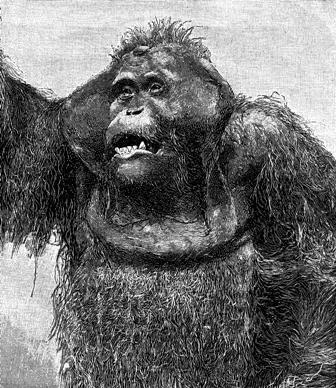Orangutans and Edgar Allan Poe

"This," I said, "is the mark of no human hand."
"Read now," replied Dupin, "this passage from Cuvier." It was a minute anatomical and generally descriptive account of the large fulvous Ourang-Outang of the East Indian Islands. The gigantic stature, the prodigious strength and activity, the wild ferocity, and the imitative propensities of these Mammalia are sufficiently well known to all. I understood the full horrors of the murder at once.
That's the solution to Edgar Allan Poe's famous mystery "The Murders in the Rue Morgue." At the time of its first publication, Western science had no clear conception of the chimpanzee or the gorilla and was only beginning to understand the habits of the orangutan. Poe was accurate to the zoology of the time, though later information has made us understand that, for example, the orang is hardly "gigantic."
Besides the great biologist Cuvier, Poe probably drew on an 1830 account by Dr. Clark Abel. Aboard a ship bound from Java to England, Abel had occasion to observe a captive orangutan. The ape had free run of the ship. It played with the sailors, racing them into the rigging. (It won.) It slept at the masthead, wrapped in an extra sail or someone's stolen shirt. It preferred fruit, but would take meat raw or cooked, bread, and eggs, and it would drink coffee, tea, and wine. Once it stole the captain's bottle of brandy. When teased too mercilessly, the orang would seize a sailor and bite him. As far as I know, this young orang didn't hurt anyone badly. But Europeans in Asia had already discovered that wild orangs, when angered, could cripple a man with bone-deep bites.
Abel's orangutan survived only fifteen months in England, apparently a victim of the climate.
*
Orangutan photos by Wayne Alison:
Next: Illustrations of Poe's Orangutan
Published on January 02, 2012 09:00
No comments have been added yet.



